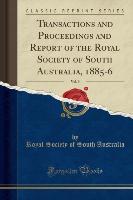Transactions and Proceedings and Report of the Royal Society of South Australia, 1885-6, Vol. 9 (Classic Reprint)
BücherAngebote / Angebote:
Excerpt from Transactions and Proceedings and Report of the Royal Society of South Australia, 1885-6, Vol. 9
Length of time. During almost all of its last apparition the general appearance was that of a Series of beautiful festoons, sometimes depending from the northern dark belt, but usually throwing out pillars to the southern and more conspicuous of the two. The interior of these festoons was generally beauti fully White by contrast with the darker matter forming their substance, and sometimes, under not very favourable atmos pheric conditions, would appear like brilliant white spots. I think it is quite possible that this has given rise to a degree of confusion with some astronomers in the northern hemisphere in respect to this part of Jupiter's surface, which will be re ferred to presently. Underneath a remarkable hollow in the south dark belt is the most striking feature on the whole planet - the great red spot. Spot is hardly an appropriate name for a space in which the whole of Australia would be lost, but it is the name that happens to be attached thereto. It is just possible that this spot was observed by Cassini in 1665 at all events, a famous spot was observfid in that year by this illus trions astronomer. The next notice of it is in 17 92, when Schroeter was observing an occultation of the planet by the moon on April '7. The most remarkable phenomena noticed were two nebulous undefined spots, perceptibly darker than the principal belt, and a still more remarkable spot is represented by Schroeter in the southern hemisphere of the planet, circular, bright in the centre, and with a dusky shading all round. A similar spot was also observed in 1786 and 17 87 In 1868 Mr. Denning records on the south belt a dark spot of elliptical form. This may have been the precursor of the great southern ellipse first observed by Mr. Gledhill on November 14, 1869. This ellipse was situated in about the same latitude as the great red spot at present is, and is very likely the same object. In fact, a sketch made on January 23, 1870, reveals a most striking similarity to the present appearance of the planet in almost every respect. The first certain record we have of the appearance of the great red spot is from some observations made at the Morrison Observatory by Professor C. W. Pritchett in July, 1878. He says On July 9 Jupiter was again examined from 11h. To 12h. 5m., G1. M. T. I was surprised at the extraordinary changes which had occurred both in the spots themselves and in the contiguous parts of the belts. Two spots still showed, but much enlarged, and with irregular outlines. Their position, however, was very different from the position noted on July 6. The place of one was a little west of the most easterly one seen on July 6, and near the inner edge of the northern equatorial belt, but the other had changed to the south side of the southern equatorial belt, and far eastward, and Seemed to be rapidly breaking up. What was more remarkable.
About the Publisher
Forgotten Books publishes hundreds of thousands of rare and classic books. Find more at www.forgottenbooks.com
This book is a reproduction of an important historical work. Forgotten Books uses state-of-the-art technology to digitally reconstruct the work, preserving the original format whilst repairing imperfections present in the aged copy. In rare cases, an imperfection in the original, such as a blemish or missing page, may be replicated in our edition. We do, however, repair the vast majority of imperfections successfully, any imperfections that remain are intentionally left to preserve the state of such historical works.
Folgt in ca. 5 Arbeitstagen


